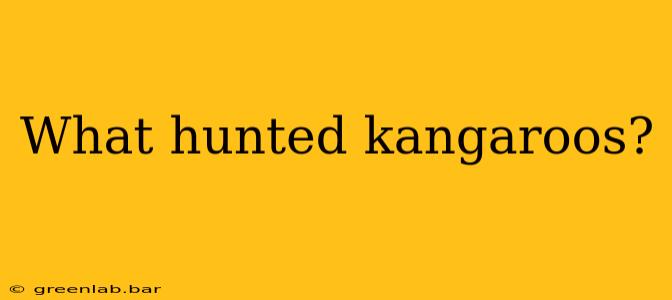Kangaroos, symbols of Australia's unique wildlife, have faced a diverse range of predators throughout their evolutionary history. While their powerful legs and hopping ability provide a significant advantage, these marsupials weren't immune to attack. Understanding their predators offers a fascinating glimpse into the ecological dynamics of the Australian landscape, past and present.
Extinct Predators: The Giants of the Pleistocene
The Pleistocene epoch, spanning from roughly 2.6 million to 11,700 years ago, saw Australia host a range of megafauna, many of which likely preyed upon kangaroos. These extinct predators significantly shaped kangaroo evolution and population dynamics:
1. Thylacoleo carnifex (Marsupial Lion): This apex predator, often considered the most formidable marsupial carnivore ever, was a powerful hunter likely capable of taking down even the largest kangaroos. Its powerful jaws and sharp claws suggest it employed ambush tactics, possibly targeting weaker or younger individuals.
2. Megalania prisca (Giant Monitor Lizard): Reaching lengths of up to 7 meters, this enormous monitor lizard was a terrifying presence in the Australian landscape. While its hunting strategies remain debated, it's highly plausible that it preyed upon smaller kangaroos and other marsupials.
3. Quinkana (Giant Crocodylian): While primarily inhabiting waterways, this massive crocodile could venture onto land, potentially ambushing kangaroos near water sources. Its size and powerful jaws made it a formidable threat to kangaroos in its range.
Modern Predators: A Different Landscape
The extinction of megafauna drastically altered the predator-prey dynamic. Today, the predators of kangaroos are considerably smaller, though still pose significant threats, particularly to younger or weaker animals:
1. Dingoes (Canis lupus dingo): Introduced to Australia thousands of years ago, dingoes are arguably the most significant present-day predator of kangaroos. They primarily target joeys (young kangaroos) and vulnerable adults, often employing pack hunting strategies.
2. Wedge-tailed Eagles (Aquila audax): These powerful birds of prey are capable of taking down smaller kangaroos, particularly red kangaroos, especially joeys. They typically target young or injured individuals.
3. Tasmanian Devils (Sarcophilus harrisii): Found only in Tasmania, these marsupial carnivores are opportunistic scavengers and predators. While they may not actively hunt large kangaroos, they are likely to prey on joeys or scavenge carcasses.
4. Human Impact: Arguably the most significant modern threat to kangaroo populations is human activity. Habitat loss, roadkill, and hunting (both legal and illegal) significantly impact kangaroo numbers and survival rates.
The Ongoing Evolutionary Arms Race
The history of kangaroo predation highlights an ongoing evolutionary arms race. The development of powerful legs and hopping ability allowed kangaroos to evade many predators. However, the emergence of new predators and environmental changes continuously present new challenges to their survival. Understanding the past and present predators of kangaroos is crucial for conservation efforts to ensure the continued survival of these iconic Australian marsupials.
Note: Research on Pleistocene megafauna and their interactions continues to evolve. New discoveries and analyses regularly refine our understanding of the past predator-prey relationships in Australia.

